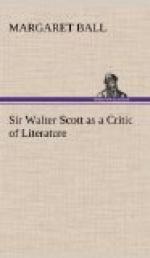Scott could hardly be called a student of Anglo-Saxon, though he was perhaps able to read the language. His remarks on the subject may, however, mean simply that he was familiar with early Middle English.[97] In his essay on Romance he referred to Sharon Turner’s account of the story of Beowulf, but called the poem Caedmon, and made no correction when he added the later footnote in regard to Conybeare’s fuller and more interesting analysis published in 1826.[98] The researches of these men indicate the state of Anglo-Saxon scholarship in England. Sharon Turner’s very inaccurate description of Beowulf was published in 1805. Danish scholars made the first translations of the poem, but no one could give a really scholarly text or translation until the year after Scott died, when the first edition by J.M. Kemble appeared. There were students of the language, however, who were doing good work in feeling their way toward a comprehension of its special qualities. One of these was George Ellis. In his Specimens he published examples of Anglo-Saxon and Middle-English poetry, and his information was helpful in enlarging Scott’s outlook. Scott’s own knowledge of Anglo-Saxon literature did not amount to enough to be of importance by itself, but it served perhaps to fortify the basis of his generalizations about all early poetry.
A review of the Life and Works of Chatterton gave Scott an opportunity to discuss the characteristics of Middle-English poetry, but his general thesis, that the Rowley poems exhibit graces and refinements which are in marked contrast to the tenuity of idea and tautology of expression found in genuine works of the period, is supported by an argument which seems to be based on a characterization of the romances rather than on a close acquaintance with other Middle-English poetry. We notice a similar quality in what Scott says elsewhere concerning Frere’s translation into Chaucerian English of the Battle of Brunanburgh: “This appears to us an exquisite imitation of the antiquated English poetry, not depending on an accumulation of hard words like the language of Rowley, which in everything else is refined and harmonious poetry, nor upon an agglomeration of consonants in the orthography, the resource of later and more contemptible forgers, but upon the style itself, upon its alternate strength and weakness, now nervous and concise, now diffuse and eked out by the feeble aid of expletives."[99] Of Middle-English poets other than Chaucer and the author or translator of Sir Tristrem, Laurence Minot was the one to whom Scott alluded most frequently, doubtless because in Ritson’s edition of Minot that poet had become more accessible than most of his contemporaries. Whatever detailed work Scott did on the poetry of this period was chiefly in connection with Sir Tristrem, which has naturally been considered in relation with his other studies in romances.




